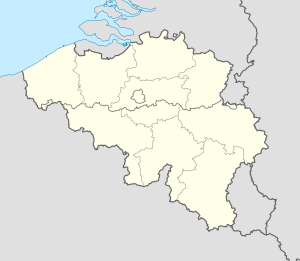Fort d'Évegnée
| Fort d'Évegnée | |
|---|---|
| Part of Fortifications of Liège | |
| Évegnée, Belgium | |

Main gate of the fortification
|
|
| Coordinates | 50°38′45″N 5°42′46″E / 50.64577°N 5.71276°E |
| Type | Fort |
| Site information | |
| Owner | Forges de Zeebrugge |
| Controlled by | Belgium |
| Open to the public |
No |
| Condition | Industrial site used for explosives storage |
| Site history | |
| Built | 1881 |
| Materials | Unreinforced concrete |
| Battles/wars | Battle of Liège, Battle of Belgium |
Coordinates: 50°38′44.9″N 5°42′46.4″E / 50.645806°N 5.712889°E
The Fort d'Évegnée is one of twelve forts built as part of the fortifications of Liège in the late 19th century in Belgium. It was built between 1881 and 1884 according to the plans of General Henri Alexis Brialmont. Contrasting with the French forts built in the same era by Raymond Adolphe Séré de Rivières, the fort was built exclusively of unreinforced concrete, a new material, rather than masonry. The fort was heavily bombarded by German artillery in the Battle of Liège in World War I and again at the opening of World War II. It is now an industrial site, used for the storage and testing of rocket propellant.
The Fort d'Évegnée is located about 9.1 kilometres (5.7 mi) east of the center of Liège near the community of Évegnée-Tignée. With the Fort de Fléron, Évignée protects the Hesbaye plain and rail access from the direction of Aachen, as well as the Hervé road.
The fort forms an isosceles triangle whose base is 200 metres (660 ft) long and whose sides measure 225 metres (738 ft). A 6-metre (20 ft) deep by 8-metre (26 ft) ditch encircles the fort. The principal armament was concentrated in the central massif. The ditches were defended in enfilade by 57mm guns in casemates resembling counterscarp batteries, firing at shot traps at the other end of the ditch. It is one of the smaller forts of Liège.
...
Wikipedia

